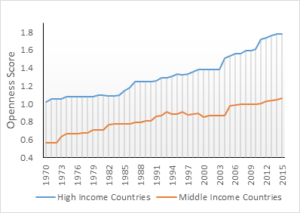 Today Sean Flynn and I are releasing the initial results of our research based on PIJIP’s Copyright User Rights Database. This research tool maps changes to copyright limitations and exceptions and other “user rights” from 1970 through 2016 in 21 countries of different development levels around the world. We intend to continue adding data from additional countries, but we feel that the current data allows us to begin demonstrating how differences in copyright user rights are associated with certain outcomes for innovative firms and researchers.
Today Sean Flynn and I are releasing the initial results of our research based on PIJIP’s Copyright User Rights Database. This research tool maps changes to copyright limitations and exceptions and other “user rights” from 1970 through 2016 in 21 countries of different development levels around the world. We intend to continue adding data from additional countries, but we feel that the current data allows us to begin demonstrating how differences in copyright user rights are associated with certain outcomes for innovative firms and researchers.
Our first results are based on tests of copyright limitation openness. We refer to “open” limitations as those that are open to the use of any kind of work, by any kind of user and for any purpose, as long as the use does not unreasonably prejudice the legitimate interests of the author. Although all countries are trending toward more open user rights, there is a clear gap between wealthy and developing countries. Developing countries in our sample are now at the level of openness that existed in the wealthy countries 30 years ago. Few countries, and almost no developing countries, have sufficient user rights most needed to support the digital economy, including for transformative use or text- and datamining.
Among the 21 countries in our sample:
- More open user rights environments are associated with higher firm revenues in information industries, including software and computer systems design.
- More open user rights environments are not associated with harm to industries known to rely upon copyright protection, such as publishing and entertainment.
- Researchers in countries with more open user rights environments produce more scholarly output and more highly-cited output.
Econometric tests described further in an upcoming working paper illustrate that these relationships are robust to inclusion of controls for relevant factors such as firm size and national wealth.
* * *
To date, there has been very little empirical work exploring how the structure of copyright limitations and other user rights shape outcomes in industries that rely upon them. One reason for this lack of empirical research on the impact of copyright user rights has been the absence of a tool to measure the key independent variable – changes in copyright user rights over time among a broad set of countries. We hope other researchers will find the Copyright User Rights database to be a useful tool for further empirical research on copyright user rights.
The User Rights Database: Measuring the Impact of Copyright Balance (PDF)




